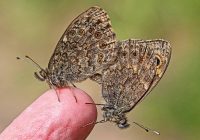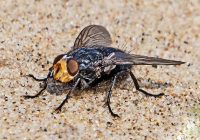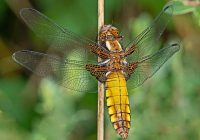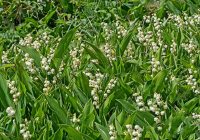Dr Phil Smith’s Wildlife Notes
May 2022
Another dry month with only nine days with measureable rainfall; as a result the sand-dune water-table fell by 12 cm. National data show it was the 5th warmest May on record, thanks largely to unusually warm nights. In our region, only 50-70% of average rainfall fell during the spring months of March to May.
As in April, my main focus was on spring-flying insects. For the first couple of weeks, at least, they didn’t disappoint. Spirits were raised on one of my regular trips along Range Lane to the Ravenmeols woods on 3rd by the gorgeous apple-green foliage of Black Poplars. Further on, the freshly opened leaves of Sycamore were black with St Mark’s Flies, while a good crop of hoverflies was crowned by a magnificent Buff-tailed Bear Hoverfly. It bears an uncanny resemblance to the Common Carder bumblebee, thereby providing the harmless hoverfly with some protection against predators. The first Common Blue butterfly of the year was a prelude to the best hatch of this species I can remember in over 50 years. Walking over to the Devil’s Hole, I estimated over 1000 Natterjack Toad tadpoles but in only 2-5 cm of water. Before the end of the month, these had succumbed to the declining water-table. Another visit to Ravenmeols two days later produced a fine Red-legged Robberfly. Although widely distributed in the country, this is a recent arrival on the Sefton Coast. Two Holly Blues reminded me it was also one of the best springs ever for them. Still more hoverflies included the Dark-backed Epistrophe a humbug-banded species that I don’t often see. However, the best was yet to come – an unmistakable Sabre Wasp, the largest of the ichneumons. It was there for a moment, right in front of me but, as I raised my camera, it disappeared. This is a great rarity in the Northwest, parasitising the larvae of wood wasps by boring into solid wood with its enormously long ovipositor. Will I ever see one again? My disappointment was assuaged a little by five Spring Heath Robberflies on a nearby log pile. During the month, I recorded 17 of these little beauties between Hightown and Ainsdale, including some areas of duneland where they hadn’t been found before.
On 8th, the first of several trips to Hightown dunes was rewarded with a new species to me, a Yellow-faced Blowfly, a large colourful relative of the bluebottles that is associated with carrion. It is described as ‘widespread but not common’. I also spotted the first Small Copper of the year. A later visit to Hightown produced a pair of the nationally declining Wall butterflies, which I persuaded to sit on my finger for a portrait. Two tiny but splendid Coastal Silver-stilettos were basking on a sandy footpath. I bumped into local naturalist Ian Wolfenden and, as we chatted, he drew my attention to a superb female Broad-bodied Chaser hung-up nearby, while five Small Heath butterflies flew past, followed by a male Brimstone, my second this year!
As everything seemed to be earlier than usual this spring, I headed to Alt Bridge on Downholland Brook on 10th to check for Large Red Damselflies and Banded Demoiselles. They are more often seen towards the end of the month. However, my timing was good; I soon found six of each in tall grassy vegetation alongside the brook. One of Britain’s most spectacular insects, the Banded Demoiselle has been breeding on Downholland Brook since at least 2005, a result of this waterway being cleaned up from its formerly polluted condition. Peak numbers came in mid-month, when I counted 25 of these amazing-looking creatures, the metallic-blue males contrasting with the bronze females.
During a visit to Haskayne Cutting Nature Reserve on 15th, insects were thin on the ground but the bird-song was really good; a cacophony of Blackcaps, Chiffchaffs, Whitethroats, a Wren and a single Yellowhammer which didn’t have to compete with traffic noise for a change. This is probably the nearest place to Formby where one can reliably expect to find a Yellowhammer, a formerly common bird. ‘Every schoolboy’ used to know its “Little-bit-of-bread-and-cheese” song. Even better, however, was a Lesser Whitethroat going full-blast from a dense bush of Grey Willow. I can’t remember having heard one here before in 50 years!
A highlight of my fortnightly visit to the Devil’s Hole on 16th was a Spotted Flycatcher in a dead tree. Like the Yellowhammer, this used to be a regular breeder in the dunes but is now a scarce passage migrant only. My bird was part of a widespread ‘fall’ of Spotted Flycatchers that day, others being reported at Hightown, Ainsdale, Birkdale and Marshside. Skirting an enormous patch of flowering Lily-of-the-valley, a garden-escape here, I struggled up a steep slope into the Devil’s Hole, counting 13 Northern Dune Tiger Beetles on the bare sand. The First Round-leaved Wintergreens were coming into flower, while delightful Common Blues were everywhere. From about 20th, hoverflies were almost completely absent, a strange event that was noticed nationally, as well as elsewhere in our region. It may be due to the prolonged spring drought, as many hoverflies have larvae that depend on moist soils and freshwater wetlands.
Trevor Davenport joined me on 27th to investigate a report of a Woodchat Shrike at Cabin Hill. We didn’t see the shrike but an unexpected bonus was a female Marsh Harrier flying over the reserve. We also found four handsome Downlooker Snipeflies on Sycamore trunks in Cabin Hill Wood. The month ended with a new plant for Freshfield Dune Heath Nature Reserve and a good one at that – a small patch of Shepherd’s-cress, a rapidly declining species that is Red-listed as ‘near threatened’ in both the UK and England and which is rare in our area.






